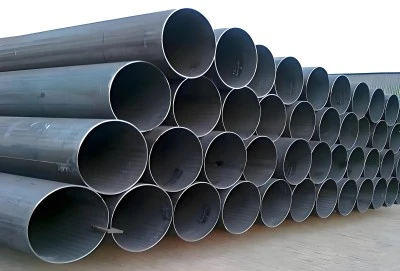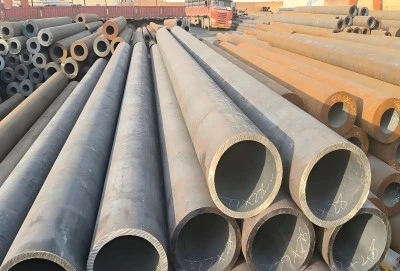When it comes to steel pipes for critical infrastructure projects, the question of interchangeability between S355 pipes and A572 Grade 50 is crucial. While both are high-strength structural steels, they're not always directly interchangeable. S355 steel pipe, commonly used in European markets, and A572 Grade 50, prevalent in North America, have similar mechanical properties but differ in chemical composition and specific standards. The decision to use one over the other depends on various factors, including project requirements, regional availability, and design specifications. Let's dive deeper into the comparison to understand when these materials can be substituted and when they cannot.
|
|
|
Comparing Yield Strength and Tensile Strength
S355 vs A572 Grade 50: Yield Strength Analysis
The yield strength of a material is a critical factor in structural engineering, determining the point at which a material begins to deform plastically. S355 steel pipe has a minimum yield strength of 355 MPa (51,500 psi), while A572 Grade 50 offers a minimum yield strength of 345 MPa (50,000 psi). This slight difference might seem negligible, but it can be significant in high-stress applications.
In pipeline projects, particularly those involving high-pressure systems, engineers must consider these yield strength variations. The marginally higher yield strength of S355 might make it preferable in scenarios where every bit of additional strength counts. However, for most general structural applications, the difference is often not substantial enough to rule out interchangeability.
Tensile Strength Comparison for Steel Pipes
Tensile strength, the maximum stress that a material can withstand while being stretched before breaking, is another crucial property. S355 steel has a tensile strength range of 470-630 MPa, while A572 Grade 50 typically ranges from 450-620 MPa. These overlapping ranges suggest that in terms of tensile strength, the two materials are quite comparable.
For applications such as bridge construction or offshore platforms, where tensile strength is a key consideration, either material could potentially be used. However, engineers must still consider other factors like weldability and impact resistance before making a final decision.
Impact on Pipe Performance in Various Applications
The performance of steel pipes in different applications depends on more than just yield and tensile strengths. Factors like ductility, toughness, and corrosion resistance also play crucial roles. S355 steel pipe is known for its excellent weldability and good low-temperature toughness, making it suitable for a wide range of applications, including offshore structures and pressure vessels.
A572 Grade 50, on the other hand, is often chosen for its high strength-to-weight ratio and good formability. It's commonly used in building frames, bridges, and transmission towers. In many cases, the performance differences between S355 and A572 Grade 50 in these applications are minimal, allowing for potential interchangeability.
International Standards: EN vs ASTM
European EN 10025 vs American ASTM A572 StandardsThe standards governing S355 and A572 Grade 50 steels are as different as their origins. S355 is specified by the European standard EN 10025, while A572 Grade 50 falls under the American Society for Testing and Materials (ASTM) A572 standard. These standards define not only the mechanical properties but also the chemical composition and testing requirements for each steel grade.
EN 10025 provides a more detailed classification system for structural steels, with various sub-grades of S355 available (e.g., S355J0, S355J2). This allows for greater specificity in material selection based on factors like impact toughness at different temperatures. ASTM A572, while less granular in its classification, is widely recognized and accepted in North American markets and beyond.
Chemical Composition Differences in S355 and A572
The chemical composition of steel significantly influences its properties and performance. While both S355 and A572 Grade 50 are low-alloy, high-strength steels, there are subtle differences in their composition that can affect their behavior in various environments and applications.
S355 steel pipe typically has slightly higher carbon content, which contributes to its marginally higher strength. A572 Grade 50, on the other hand, often contains more manganese, which enhances its weldability. The precise compositions can vary within the limits set by their respective standards, but these general trends hold true.
Global Acceptance and Specifications for Steel Pipes
In an increasingly globalized construction and engineering industry, the acceptance of different steel standards varies by region and project specifications. Many international projects now accept both EN and ASTM standards, recognizing the similarities between S355 and A572 Grade 50 steels.
However, it's crucial to note that some regions or specific industries may have a strong preference for one standard over the other. For instance, European projects often strictly require EN-standard materials, while North American projects might insist on ASTM-compliant steels. Understanding these regional preferences and regulatory requirements is essential when considering the interchangeability of S355 and A572 Grade 50 pipes.
Design Considerations: When Substitution is Possible?
Engineering Factors for S355 and A572 InterchangeabilityWhen considering the substitution of S355 steel pipe with A572 Grade 50 or vice versa, engineers must evaluate several factors beyond just strength properties. Weldability is a critical consideration, especially in complex structural assemblies. Both steels offer good weldability, but slight differences in their chemical composition may require adjustments in welding procedures.
Fatigue resistance is another crucial factor, particularly in applications involving cyclic loading, such as bridges or offshore structures. While both steels perform well under fatigue conditions, specific project requirements may favor one over the other. Additionally, the ease of forming and fabrication should be considered, as it can significantly impact project timelines and costs.
Industry-Specific Requirements for Steel Pipe Selection
Different industries have varying requirements for steel pipe selection. In the oil and gas sector, for instance, resistance to hydrogen sulfide (H2S) stress cracking is often a critical factor. While both S355 and A572 Grade 50 can be manufactured to meet these requirements, specific grades or heat treatments might be necessary.
For water supply systems, corrosion resistance becomes paramount. Here, the slight differences in chemical composition between S355 and A572 Grade 50 might influence the choice, depending on the specific environmental conditions. In bridge construction, the ability to maintain structural integrity in extreme temperatures might tip the scales in favor of one material over the other.
Cost-Benefit Analysis of S355 vs A572 Grade 50 Usage
The decision to use S355 or A572 Grade 50 steel pipes often comes down to a careful cost-benefit analysis. While the materials themselves are generally comparable in price, factors like availability in different regions can significantly impact overall project costs. In some cases, choosing a more readily available option might offset any minor performance differences.
Long-term maintenance costs should also be considered. If one material offers slightly better corrosion resistance or fatigue performance in a specific application, it might prove more economical over the structure's lifetime, despite potentially higher initial costs. Project managers and procurement specialists must weigh these factors carefully, considering both immediate budget constraints and long-term performance requirements.
S355 Steel Pipes Supplier
For high-quality S355 steel pipe, Hebei Longma Group stands out as a reliable supplier. With advanced production equipment imported from Germany and independently developed technologies, Longma ensures top-notch quality. They provide complete certifications, including API 5L and ISO 9001, meeting global standards. Thanks to stable raw material partnerships and efficient production, Longma offers competitive pricing without compromising quality. For your S355 or A572 Grade 50 steel pipe needs, contact us at info@longma-group.com.














